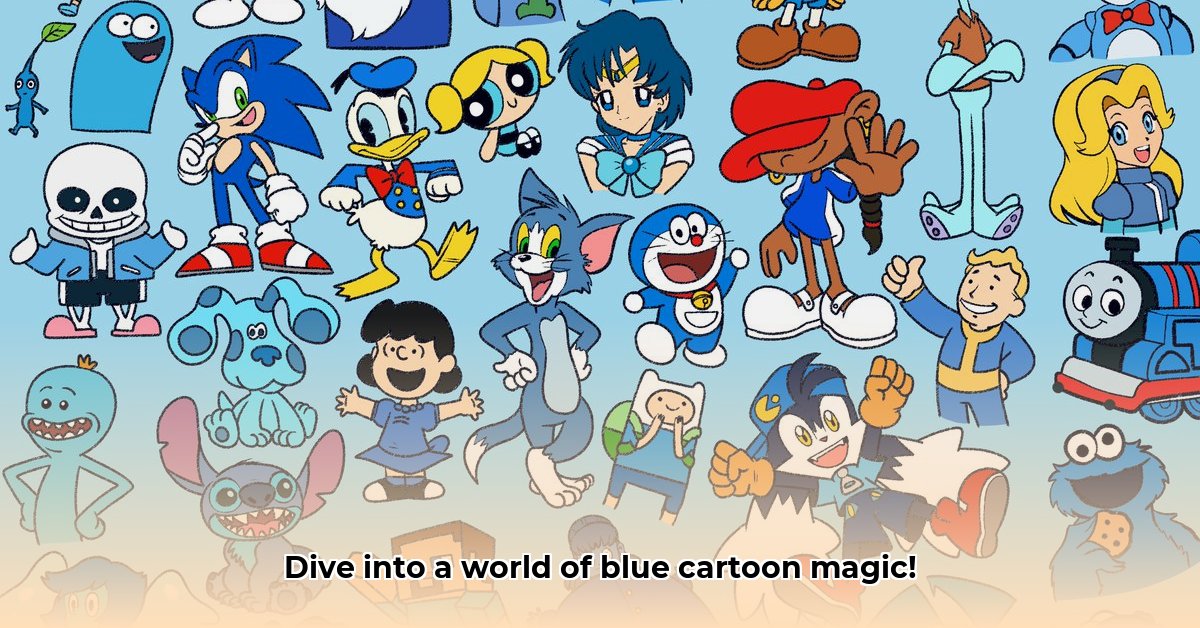Ever notice how many awesome cartoon characters are blue? It’s not just a coincidence! From the speedy Sonic to the lovable Stitch, blue seems to be a popular choice for animators. This article explores the surprising reasons behind blue’s popularity in cartoons, looking at how different shades of blue create different personalities and how it all adds up to making these characters so memorable. We’ll explore some of your favorite blue characters and see what makes them tick—and how their color plays a big part in their success.
Blue Cartoon Characters: An Ultimate Guide
The vibrant world of animation is bursting with color, but one hue reigns supreme: blue. Why are so many beloved cartoon characters blue? It’s more than just a pretty color; it’s a clever storytelling tool that taps into our emotions and creates memorable characters. Blue, depending on the shade, can be calming, trustworthy, mysterious, or even a little sad. This versatility allows creators to craft characters with a wide range of personalities and roles. Let’s dive into the fascinating world of blue cartoon characters! What makes these characters so engaging, and what narrative effect do they achieve?
A Kaleidoscope of Blues: Shades of Character
Before we meet the stars, let’s talk about the different shades of blue and how they impact character design. A bright, almost electric blue suggests energy and excitement, perfect for a speedy superhero or a mischievous alien. A softer, more muted blue might hint at calmness and wisdom, fitting for a spiritual leader or a thoughtful friend. And a deep, rich navy blue could communicate strength, power, or a touch of mystery, ideal for a superhero or a powerful villain. The choices are endless! How can the effective use of different color variations influence character design?
Meet the Blue Crew: Iconic Characters and Their Hues
Here are some unforgettable blue cartoon characters, showcasing the amazing variety of blue’s expressive potential:
-
Stitch (Lilo & Stitch): The mischievous alien experiment from Disney’s Lilo & Stitch, Stitch, boasts a distinctive cobalt blue fur that hints at his extraterrestrial origins and playful nature. This unique shade sets him apart, symbolizing his chaotic yet endearing personality. His blue is a visual cue to his initial destructive programming, softened by the Aloha spirit he embraces.
-
Sonic the Hedgehog (Sonic the Hedgehog Franchise): Sonic’s iconic electric blue fur is practically synonymous with speed and energy. This vibrant hue instantly conveys his whirlwind personality and fast-paced adventures. The choice of electric blue perfectly embodies his agility and represents the cutting-edge technology of the Sonic universe.
-
Dory (Finding Nemo/Finding Dory): Dory, the lovable Royal Blue Tang Fish, illuminates the screen with her bright, happy blue hue. This cheerful, approachable blue perfectly matches her charming, optimistic, and somewhat forgetful personality. Her color reflects her unwavering loyalty and symbolizes the vastness of the ocean she calls home.
-
Genie (Aladdin): The Genie’s shimmering, almost iridescent cerulean blue perfectly reflects his magical nature and limitless energy. His vibrant, intense blue is like looking straight into a magical wellspring of boundless power and whimsical fun. The shimmering effect enhances his otherworldly presence, highlighting his status as a wish-granting entity.
-
Cookie Monster (Sesame Street): While a monster, Cookie Monster’s bright navy blue fur is instantly recognizable and contributes directly to his comedic appeal. The bright, playful blue matches his fun-loving personality and his insatiable appetite. It is a comforting color, making him approachable despite his monstrous appearance and obsession with cookies.
-
The Smurfs (The Smurfs): These small, blue creatures are known for their distinct appearance. Their skin is a bold, vibrant blue that contrasts nicely with their white hats. The choice of blue for the Smurfs conveys a sense of unity and harmony in their community, while also symbolizing their connection to nature and the enchanted forest they inhabit.
-
Bluey (Bluey): The adorable Blue Heeler puppy from the hit Australian children’s show, Bluey, sports a soft, gentle sky blue fur. This choice reflects the show’s wholesome tone and reinforces Bluey’s playful, friendly personality. This calm blue versus a high-energy blue represents her innocence and the show’s focus on family and imagination.
-
Mystique (X-Men): The shape-shifting mutant from Marvel Comics, Mystique, is known for her striking blue skin. Her deep indigo blue hue communicates strength, mystery, and a touch of the unknown. It’s a powerful blue, reflecting her complex role and the gravity of the situations she faces as both a villain and anti-hero.
-
Ice King (Adventure Time): The misunderstood villain from Adventure Time, Ice King, has pale blue skin and wields ice powers. His light azure blue skin tone hints at his cold and lonely nature. Combined with his long white beard, the blue emphasizes his age and the tragic story of his past.
-
Blue Falcon (Dynomutt, Dog Wonder): The crime-fighting superhero, Blue Falcon, sports a full cerulean blue costume. The falcon emblem on his chest stands out, making him known for his witty one-liners and his determination to always do the right thing. He is a brave and dedicated hero who is always ready to save the day.
The Enduring Legacy of Blue Cartoon Characters
These are just a few of the many iconic blue cartoon characters. Their enduring popularity, evident in the mountains of merchandise and continued fan engagement, proves the effectiveness of this color choice. The impact of these characters—and the strategic use of blue in their designs—goes far beyond the screen; they’ve become integral parts of our collective cultural memory, a testament to the powerful effect of color in shaping characters and their roles in our shared stories. What other blue characters can you think of? What makes their specific shade of blue so memorable to you? The research on color psychology in character design is ongoing, so perhaps you’ll be the one to discover the next generation of blue-hued animated icons! Is blue’s use in animation evolving and adapting to modern audience expectations?
How to Use Color Psychology to Design Successful Blue Cartoon Characters
Key Takeaways:
- Blue’s versatility in character design allows for a wide range of interpretations, from heroic figures to mischievous villains.
- Understanding different shades and saturation levels of blue is crucial for achieving the desired effect.
- Successfully using blue involves considering cultural associations and the character’s personality.
- Effective blue character designs leverage blue’s psychological associations to create memorable and impactful characters.
The Allure of Blue: A Spectrum of Personalities
Why are so many beloved cartoon characters blue? It’s more than just a coincidence. The color blue, in character design, carries significant weight. It’s a versatile hue, capable of conveying a broad spectrum of emotions and traits. How to use color psychology to design successful blue cartoon characters hinges on understanding this versatility. Let’s dive into some iconic examples. What specific emotional or psychological effect does blue have that makes it so popular in animation?
Deconstructing Famous Blue Characters: A Case Study
-
Sonic the Hedgehog: His vibrant, almost electric blue fur perfectly embodies speed and energy. This isn’t just an aesthetic choice; it’s a powerful psychological cue that reinforces his personality. The saturation level is key; a dull blue wouldn’t capture Sonic’s dynamic essence.
-
Smurfette (The Smurfs): Contrast Smurfette’s bright, almost electric blue with the more muted blues of the male Smurfs. Her vivid hue helps establish her as a unique female figure within a primarily male ensemble. It enhances her playful nature while establishing her strong visual identity.
-
Bluey (Bluey): Bluey uses a softer, gentler blue—a different shade entirely. This pastel blue reflects the show’s wholesome tone and reinforces Bluey’s playful, friendly personality. It’s a calm blue versus a high-energy blue—a subtle yet powerful contrast.
-
Avatar: The Last Airbender – Water Tribe Characters: The water tribe’s association with cool shades of blue and teal reflects their calming nature and connection to water. It reflects their spiritual connection to nature, visually establishing them as a calm yet powerful group.
-
Captain America (Marvel Comics): While not solely blue, the prominent use of blue in Captain America’s costume reinforces his heroic image. The deep blue hue evokes feelings of trustworthiness and stability, qualities central to his persona.
Unlocking the Power of Blue’s Psychological Associations
Blue is often associated with calmness, trustworthiness, and stability. However, the shade and saturation drastically alter its impact. A deep, saturated blue can convey authority and seriousness, while a lighter pastel blue can suggest innocence and gentleness. How to use color psychology to design successful blue cartoon characters is about mastering this nuance. How can the texture and contrast of blue enhance its emotional effect in character design?
Beyond the Hues: Texture and Contrast
The texture and contrast also matter. A smooth, shiny blue might represent sleekness and technology, while a rough, textured blue could suggest ruggedness and strength. Consider the overall aesthetic of your design, ensuring a harmonious balance. Contrast is key; using complementary colors can create visual interest and further emphasize the blue tones.
Cultural Considerations: A Global Perspective
Remember, color associations vary across cultures. What evokes a feeling of calm in one culture might provoke a different emotion in another. Research to ensure your blue character resonates universally. In Western cultures, blue is
- Lyrics Competition Offers Prizes And Valuable Industry Feedback - December 15, 2025
- Major Lyric Contest Opens Doors for Aspiring Songwriters - December 14, 2025
- American Song Contest 2025 Invites Songwriters To Impress Industry Experts - December 13, 2025










